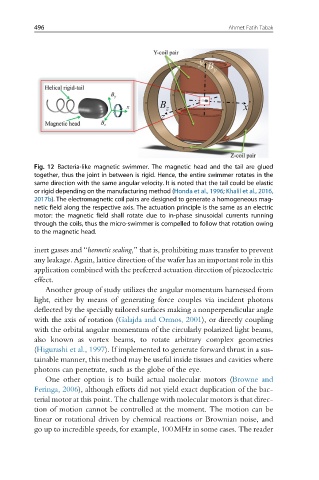Page 502 - Handbook of Biomechatronics
P. 502
496 Ahmet Fatih Tabak
Fig. 12 Bacteria-like magnetic swimmer. The magnetic head and the tail are glued
together, thus the joint in between is rigid. Hence, the entire swimmer rotates in the
same direction with the same angular velocity. It is noted that the tail could be elastic
or rigid depending on the manufacturing method (Honda et al., 1996; Khalil et al., 2016,
2017b). The electromagnetic coil pairs are designed to generate a homogeneous mag-
netic field along the respective axis. The actuation principle is the same as an electric
motor: the magnetic field shall rotate due to in-phase sinusoidal currents running
through the coils, thus the micro-swimmer is compelled to follow that rotation owing
to the magnetic head.
inert gasses and “hermetic sealing,” that is, prohibiting mass transfer to prevent
any leakage. Again, lattice direction of the wafer has an important role in this
application combined with the preferred actuation direction of piezoelectric
effect.
Another group of study utilizes the angular momentum harnessed from
light, either by means of generating force couples via incident photons
deflected by the specially tailored surfaces making a nonperpendicular angle
with the axis of rotation (Galajda and Ormos, 2001), or directly coupling
with the orbital angular momentum of the circularly polarized light beams,
also known as vortex beams, to rotate arbitrary complex geometries
(Higurashi et al., 1997). If implemented to generate forward thrust in a sus-
tainable manner, this method may be useful inside tissues and cavities where
photons can penetrate, such as the globe of the eye.
One other option is to build actual molecular motors (Browne and
Feringa, 2006), although efforts did not yield exact duplication of the bac-
terial motor at this point. The challenge with molecular motors is that direc-
tion of motion cannot be controlled at the moment. The motion can be
linear or rotational driven by chemical reactions or Brownian noise, and
go up to incredible speeds, for example, 100MHz in some cases. The reader

